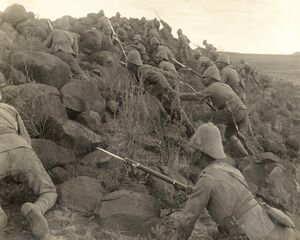Battle of the Abronian River
| Battle of the Abronian River | |||||||
|---|---|---|---|---|---|---|---|
| Part of Black February | |||||||
 Imperial Marines seek cover in rocky ground | |||||||
| |||||||
| Belligerents | |||||||
|
|
| ||||||
| Commanders and leaders | |||||||
|
Commodore Sir Arthur Cavendish | Yusuf Slatir | ||||||
| Units involved | |||||||
|
| |||||||
| Strength | |||||||
|
| 6,000 | ||||||
| Casualties and losses | |||||||
|
| 400 casualties | ||||||
| 3000 civilians were evacuated and 102 killed during the fighting | |||||||
The Battle of the Abronian River was an incident during Black February, an intense period of civil violence in Prodava which saw its transition from monarchy to republic. It is considered by some to be the first engagement of the Prodavan War. The 3rd Light Squadron of the Vionna-Frankenlischian Imperial Navy, under the command of Commodore Sir Arthur Cavendish, oversaw the evacuation of Prodavan monarchist civilians and troops from Salorka Province in northern Prodava. Three-hundred Imperial marines and 2,500 Prodavan monarchist troops held off an assault by six-thousand republican rebels, ensuring a successful evacuation.
Background
In the wake of the death of the last Prodavan Sultan, Abu Taiseer Al-Shahid, Prodava had wasted no time in falling into anarchy and civil violence. The police were unable to contain the unrest and, in a vain attempt to stem the unrest that would become Black February, the two paramilitary units that served the Prodavan government were ordered into the streets: the monarchist Mameluk Guard and the nationalist Bedouin Guard. In a matter of hours, the the two groups began to fight each other in the streets of the capital. Once this had happened, there was little chance of saving the situation. In the so-called Greenshirt Coup, the Bedouins began a nation-wide takeover in aid of a Prodavan republic. Massacres and other atrocities were commonplace amongst the violence and Mameluks and suspected royalists were killed en-masse.
In northern Prodava, where monarchist support was highest, escape to Vionna-Frankenlisch was the obvious choice. Under the command of Osman Majid, the Ramubad Mameluk Guard simply marched across the border to be interned. Nobles and detracters from the republican cause fled across the Imperial border in Kundaki Province, Salorka Province and Ramubad Province. HMNS Odon, carrying a new consul to the Prodavan posession of Caledonia was swarmed by local notables attempting to flee the country. A decision by the Vionna-Frankenlischian government to begin evacuations came far too late to help most people, but for the 11,000 refugees hoping to flee Salorka Province by sea it would be a deliverance. Mehmet Mustafari Pasha, with 2,500 men of the Salorka Memeluk Guard, led the refugees to the coast along the River Abronia where they were to meet the Third Light Squadron of the Imperial Navy.
Under the command of Sir Arthur Cavendish, the Third Light Squadron was made up of seven River-class destroyers and was escorting thirty civilian ships which were to carry the refugees for safety. With Republican forces closing in swiftly on Mehmet Mustafari's camp, the squadron abandoned the civilian ships to gain speed and sailed up the River Abronia to land marines and help defend the camp. Led by Brigadier Harriet Mackensen of the Imperial Marines, three-hundred marines and two-hundred armed sailors came ashore on boats to bolster the defence.
Battle
Yusuf Slatir, commander of the Salorka Bedouin Guard, had force-marched his 2,000 Bedouin guardsmen and 4,000 Republican rebels to keep pace with Mehmet Mustafari's retreating refugees and Mameluks. By the time Mustafari had set up his camp, the pursuing Republicans were exhausted from the march and low on supplies. They rested during the 17th rather than attacking, a decision which allowed Sir Arthur Cavendish's Third Light Squadron to sail up the River Abronia overnight and land 500 men in small boats in the early hours of the morning. Besides their Metford rifles, the Imperial marines were armed with mountain guns and their odd M1895 machine guns. Imperial Navy sailors, 200 of which landed with the marines, mostly caried surplus Metford rifles but some carried the outdated Snider instead. Ammunition for this weapon was scarce and, of the forty-four Snider rifles issued on 17th February, nine were returned on 19th February and not a single round of .577 ammunition could be found. However, twenty-eight Mauser rifles were handed in by sailors, all of which bore Prodavan markings.